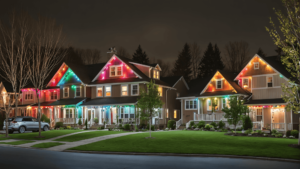Accent lighting plays a crucial role in interior design, allowing you to highlight architectural features, create focal points, and enhance the ambiance of your home. From subtle wall sconces to dramatic pendant lights, accent lights come in a variety of styles and forms to suit every taste and decor scheme.
In this comprehensive guide, we’ll explore the various ways you can add Austin house accent lights to your home interior, from selecting the right fixtures to strategically placing them for maximum impact.
Understanding the Basics of Accent Lighting:
Before diving into specific techniques, it’s essential to understand the basics of accent lighting. Accent lights are used to draw attention to specific areas or objects in a room, such as artwork, architectural details, or decorative elements. Unlike ambient lighting, which provides overall illumination, accent lights are more focused and directional, allowing you to create depth and visual interest in your home interior.
Choose the Right Fixtures:
The first step in adding accent lights to your home interior is selecting the right fixtures for your space. Consider the style and decor of your home, as well as the function of the room where the accent lights will be installed.
For example, in a traditional living room, wall sconces or picture lights may be the perfect choice for highlighting artwork or architectural features. In a modern kitchen, track lighting or recessed fixtures can provide focused task lighting while adding a sleek and contemporary touch.
Determine the Purpose:
Before adding accent lights to any room, consider the purpose they will serve. Are you looking to create a cozy atmosphere in a bedroom or living room? Do you need task lighting for a home office or kitchen? Are you hoping to highlight a specific architectural feature or piece of artwork? By determining the purpose of the accent lights, you can better select the appropriate fixtures and placement for your space.
Layering Light:
A key principle of interior lighting design is layering light, which involves using a combination of ambient, task, and accent lighting to create a balanced and visually appealing environment. When adding accent lights to your home interior, consider how they will complement existing lighting sources and contribute to the overall ambiance of the room.
For example, pairing recessed ceiling lights with wall-mounted sconces or floor lamps can create layers of light that add depth and dimension to your space.
Focus on Focal Points:
One of the most effective ways to use accent lights is to highlight focal points in your home interior. These could be architectural features such as fireplace mantels, built-in bookcases, or crown moldings, or decorative elements like artwork, sculptures, or houseplants. By strategically placing accent lights near these focal points, you can draw attention to them and create visual interest in your space.
Consider Dimmers:
Dimmer switches are an essential tool for controlling the intensity of accent lights and creating the desired ambiance in your home interior. By installing dimmer switches for your accent lighting fixtures, you can easily adjust the brightness level to suit different activities and moods.
For example, dimming the lights in a dining room can create a romantic atmosphere for dinner parties, while brightening them in a home office can enhance productivity and focus.
Play with Color Temperature:
The color temperature of accent lights can have a significant impact on the look and feel of your home interior. Warm white tones (2700-3000 Kelvin) create a cozy and inviting atmosphere, perfect for living rooms, bedrooms, and dining areas. Cool white tones (3500-4100 Kelvin) are ideal for task lighting in kitchens, bathrooms, and home offices, providing bright, energizing light. Consider using color-changing LED bulbs or smart lighting systems to adjust the color temperature of your accent lights to suit different activities and occasions.
Strategic Placement:
You can even consider the placement of Austin outdoor home accent lighting to ensure they have the desired impact. Avoid placing accent lights too close together or too far apart, as this can create uneven lighting and shadows.
Instead, aim for balanced and uniform illumination that highlights key features and creates a cohesive look throughout the room. Experiment with different angles, heights, and distances to find the perfect placement for your accent lights.
Conclusion:
Accent lighting installation Austin is a simple and effective solution to enhance the beauty, functionality, and ambiance of your overall interiors.
By choosing the right fixtures, determining their purpose, layering light, focusing on focal points, considering dimmers and color temperature, and strategically placing them throughout your space, you can create a warm, inviting, and visually stunning environment that reflects your style and enhances your quality of life.
So go ahead and illuminate your home interior with accent lights, and watch as it transforms into a place of comfort, beauty, and inspiration.
You May Also Like: What to Consider When Installing Accent Lights to Achieve the Perfect Outdoor Ambiance?




